1lumen selects and reviews products personally. We may earn affiliate commissions through our links, which help support our testing.
Amutorch BT60 review: LEP flashlight
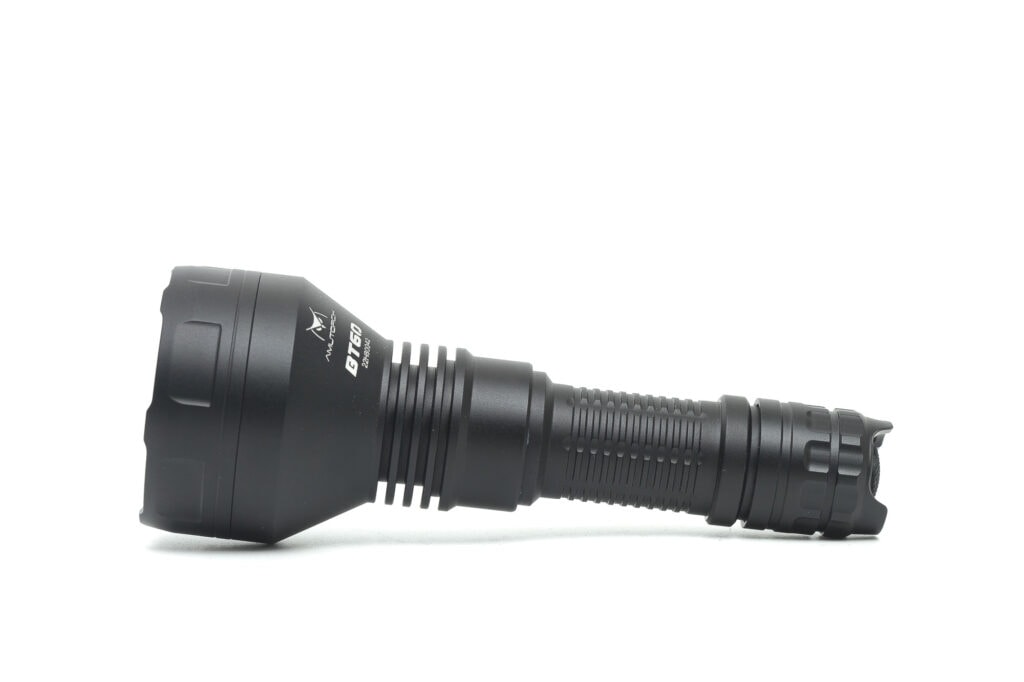
Amutorch BT60 specifications
| Brand/model | Amutorch BT60 |
|---|---|
| Flashlight category | LEP / long-range / search |
| LEP | shine through LEP module |
| Max. output | 400 Lumens |
| Max. beam distance | 2560 meters |
| Max. beam intensity | 1,640,000 cd |
| Battery config. | 1*21700 |
| Onboard charging | N/A |
| Modes | 2 |
| Blinkies | N/A |
| Waterproof | IPX8 |
| Review date | October 2022 |
Introduction:
When Maglite was your go-to flashlight 20 years ago, you probably wouldn’t have thought flashlights could reach over 1 mile. Especially not when someone said that the flashlight would be shorter than most maglites and throw 100 times as far…. Well, time has changed.
LEP flashlights have gotten very popular ever since we started concentrating on reviewing LEP flashlights. They are long-range flashlights with a blue laser as its light source. With some techniques, the blue laser turns into a white beam, so it looks similar to an LED flashlight.
The Amutorch BT60 is the 3rd LEP flashlight made by Amutorch. The others are the Amutorch BT55 (zoomy) and the Amutorch BT35. I don’t own the former, but it looks similar to the Maxtoch LA60, and the latter is one of my favorite LEPs…
Anyway, the BT60 looks quite promising, with a claimed beam intensity of 1.6 million candelas.
Let’s dive into the review.
Package quality.
The package was a pretty standard brown cardboard box, with the following inside:
- The flashlight: Amutorch BT60
- Holster
- Lanyard
- 1 o-ring
- Rubber/silicon cigar grip ring (tactical ring)
- Manual? in Chinese
This is a pretty standard package, and keep in mind that the manual is only in Chinese.
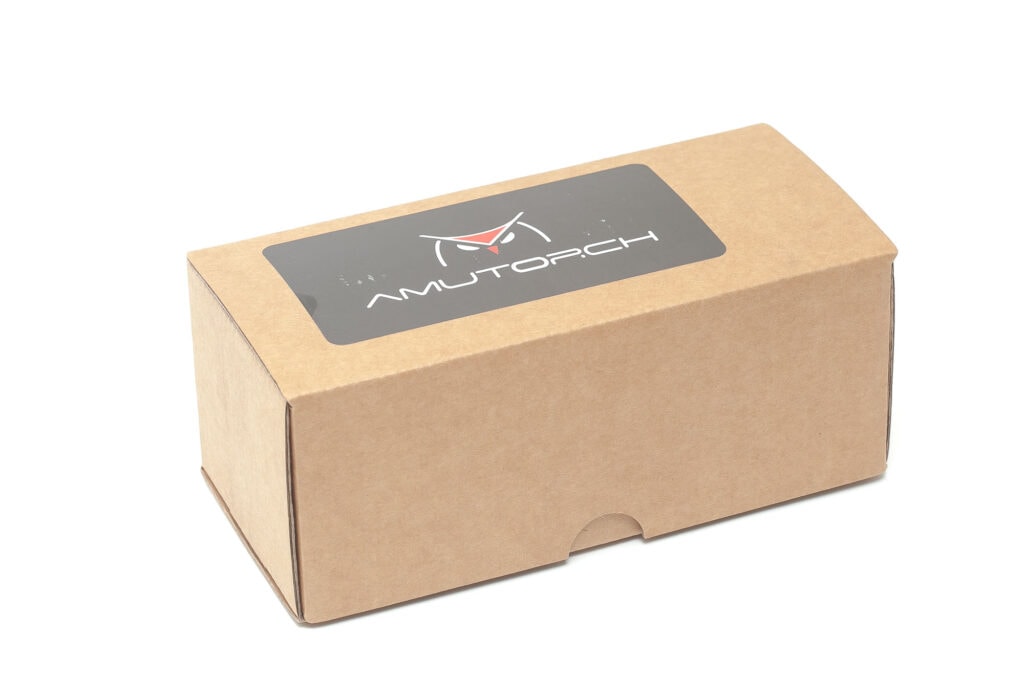
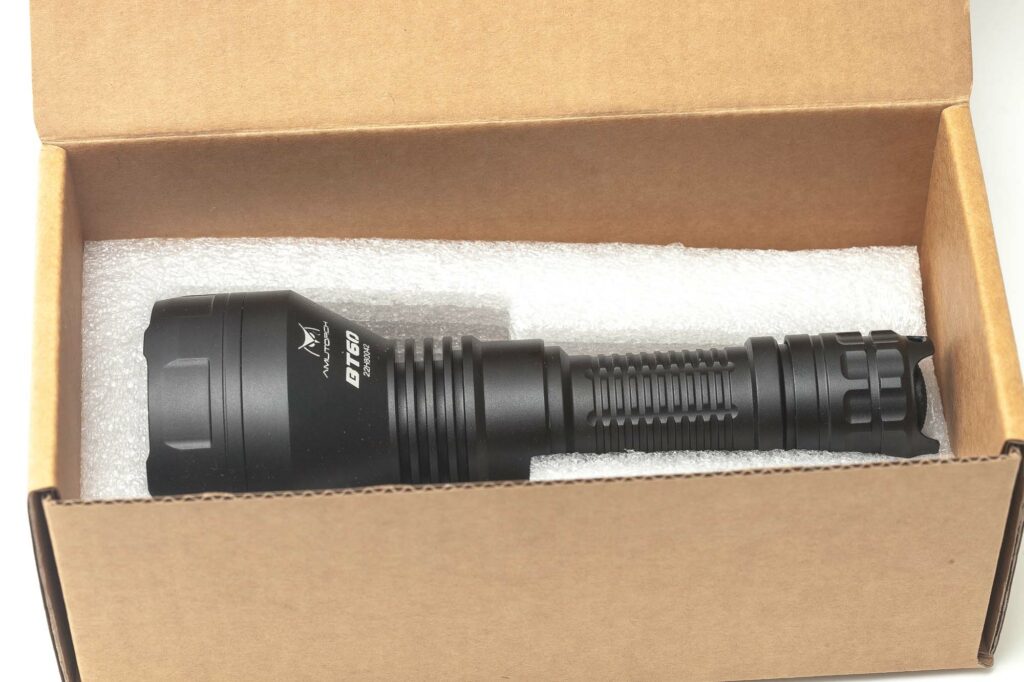
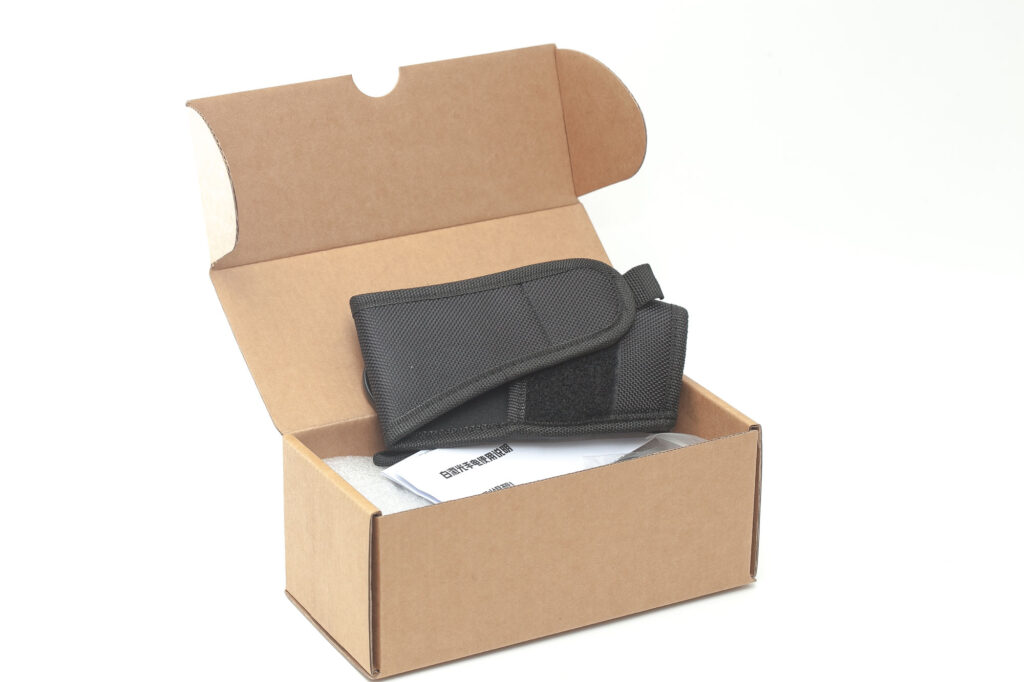
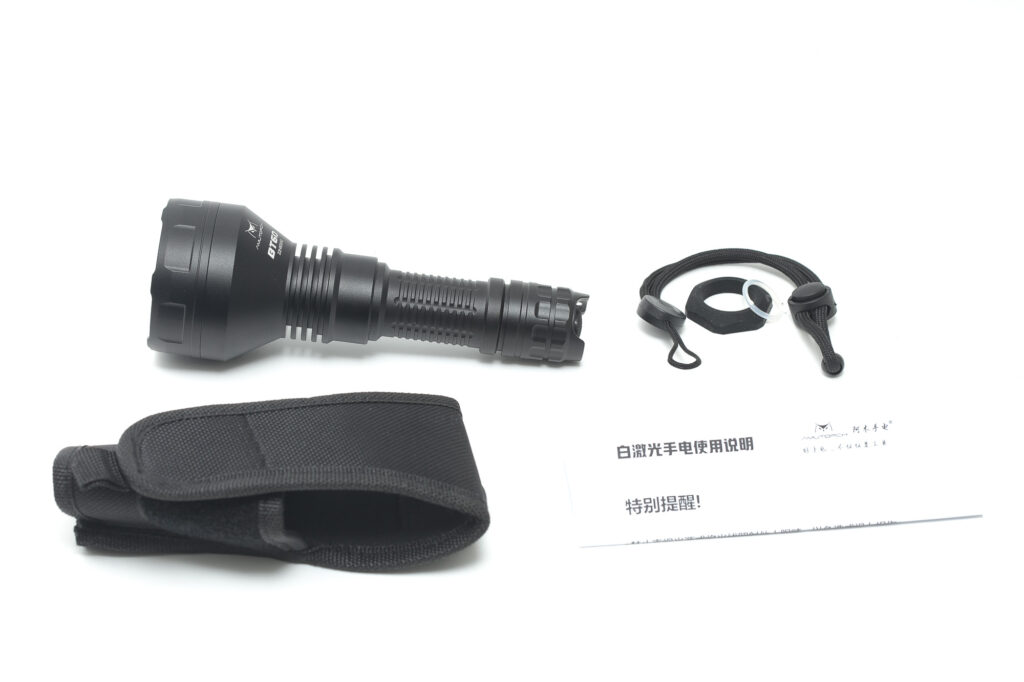
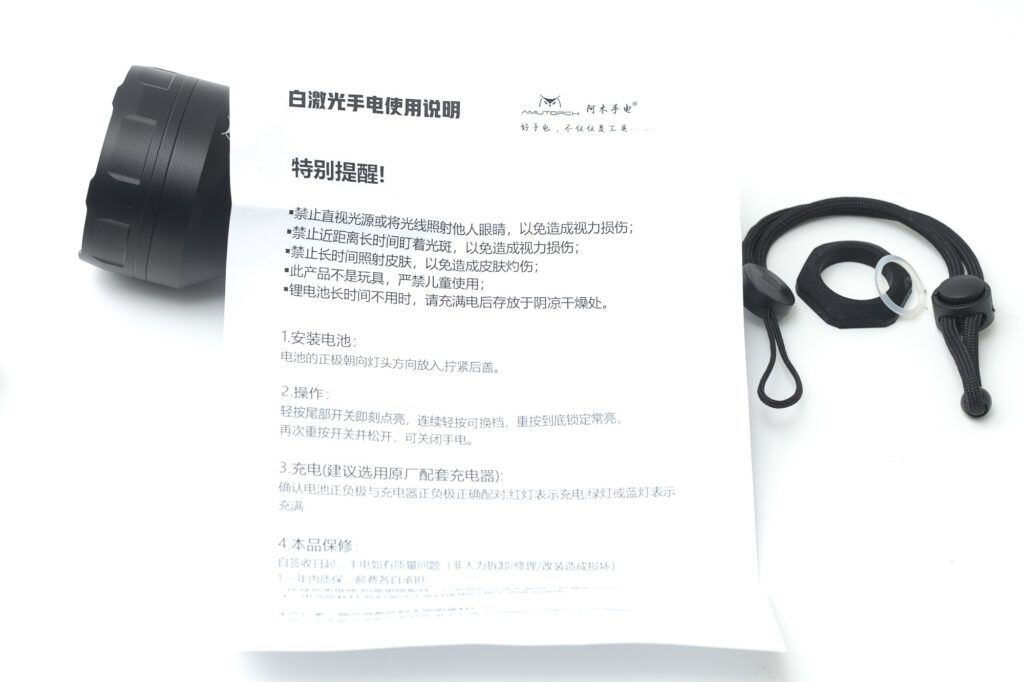
Flashlight in use
While many people in the flashlight community like a sophisticated UI that can be customized to your liking, some flashlights don’t need it…. at least that’s my opinion. And this is one of those times that a simple UI feels more fit.
The BT60 has a simple forward-clicky switch and only 2 modes. It’s also the shortest big-head LEP I currently own. The switch is protected by 2 small ridges, of which 1 can be used to attach your lanyard to.
Since the body has some knurling with horizontal and vertical grooves, the flashlight doesn’t feel too slippery. But if you worry about dropping it, use the tactical grip ring, that Amutorch includes.
You’d have to slip it on from the rear, so it sits right at the end of the battery tube.
Having installed this ring, you can hold it firmly with a cigar grip. That way the BT60 feels a bit more tactical than most other LEPs. But the ring doesn’t help too much from letting the flashlight roll off a slightly inclined surface or table. It’s just a little too small for that.
Being an LEP, you don’t buy the BT60 for close-up work, like searching for your dropped keys, or finding the lock on your door. LEPs are made for long-distance use only. I mean, there are some cases you could use for close-up. Once, there was an arborist reaching out asking for a recommended flashlight to point out limbs to be pruned from trees. That’s still pretty close up in my opinion.
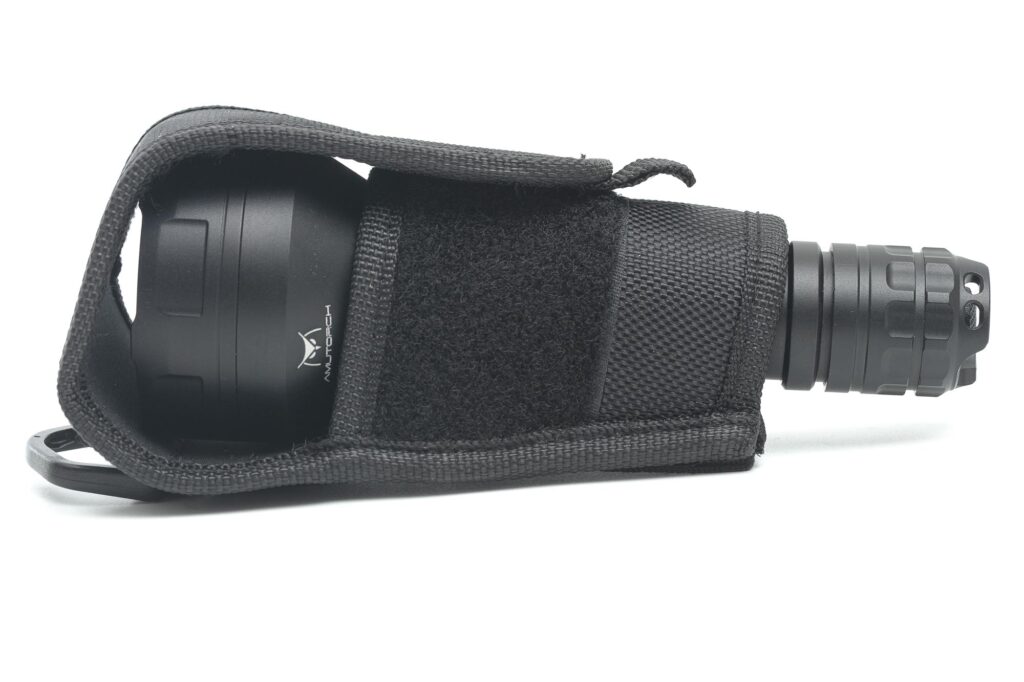
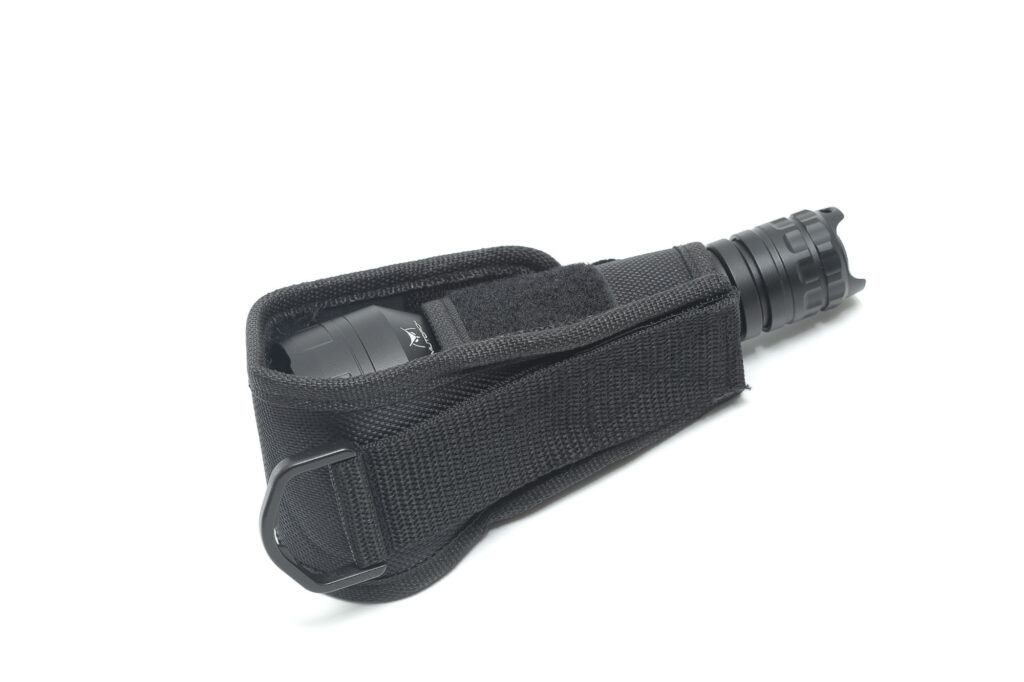
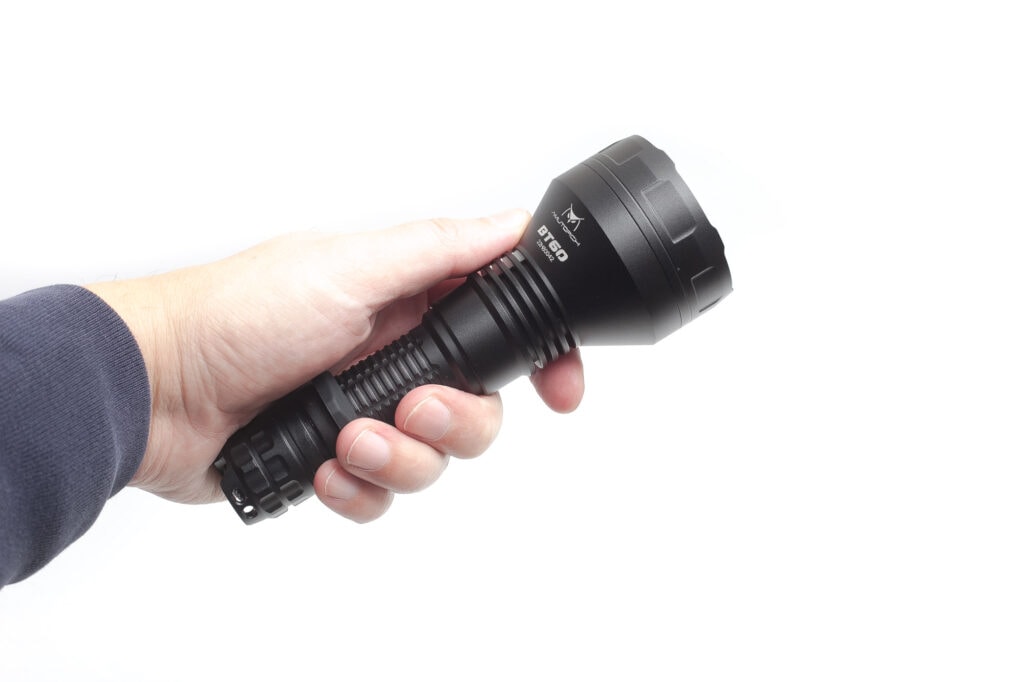
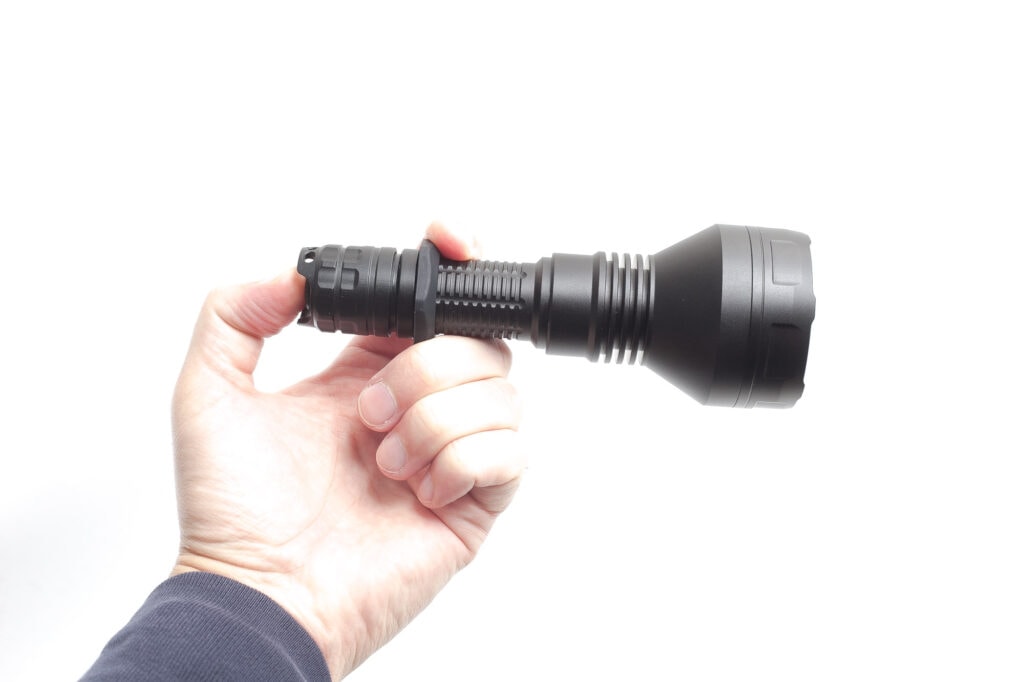
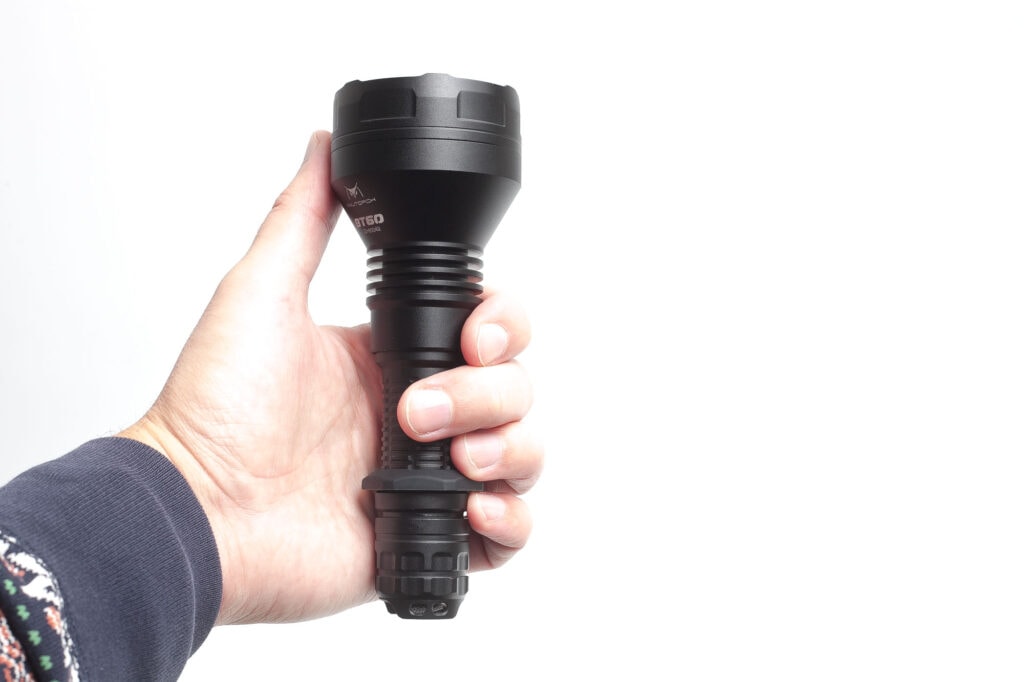
Build Quality, and Warranty
Alright, if you have read some of our other Amutorch reviews, you’ll notice there is a returning element to them. Especially in this part of the review.
Amutorch makes nice flashlights but their designs, and finish aren’t usually at the top of the list. Not that they are bad, but they don’t spend a whole lot of attention on details. But if you don’t care too much about design, and care more about its performance, then don’t worry. The BT60 is a pretty affordable LEP, and beats many of its competitors in price, and performance…
The BT60 looks nicely machined and well-anodized. All edges are nicely chamfered and don’t feel sharp.
Warranty? From Amutorch.com: 1 year warranty – AMUTORCH offers free warranty work if the problem is caused by normal usage within 1 year after receipt. Lifetime warranty – For the life of your light, repairs will be made with no labor charges as long as parts are available from AMUTORCH. You will be charged for the parts needed to repair your light. The following situations are excluded from warranty–Damage caused by improper disassemblement, modification, and improper usage is excluded from the warranty. The battery is excluded from the warranty. If the battery doesn’t work upon receipt, it could be replaced. Accessories that come along with flashlights such as lanyards, bags, o-rings, etc. are not covered by the warranty.
But you should always first reach out to your dealer. They can usually resolve the problem for you.
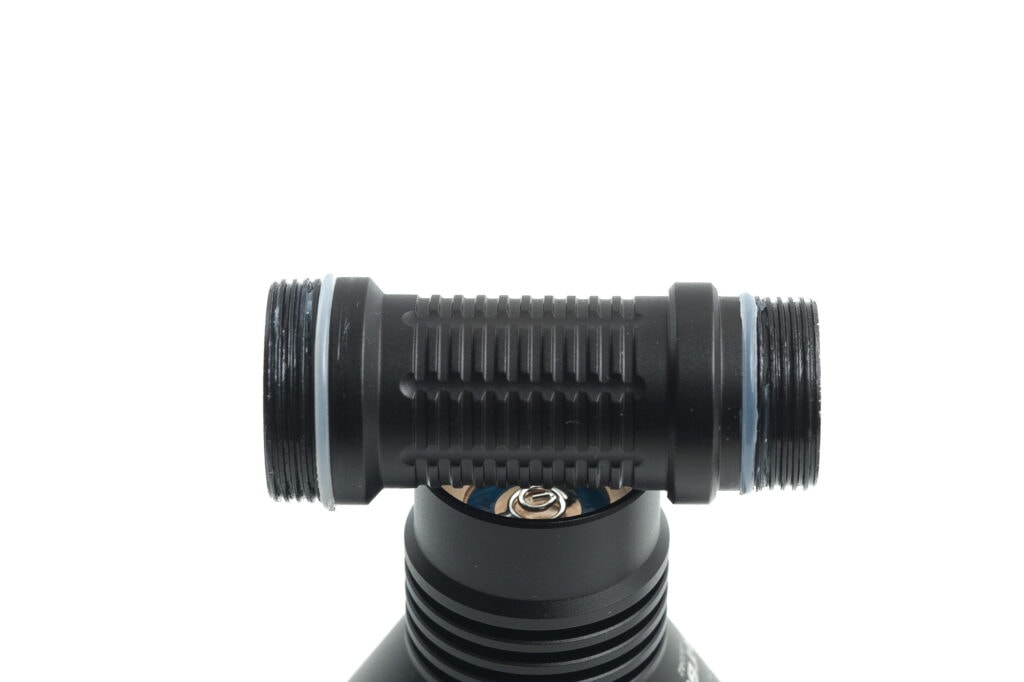
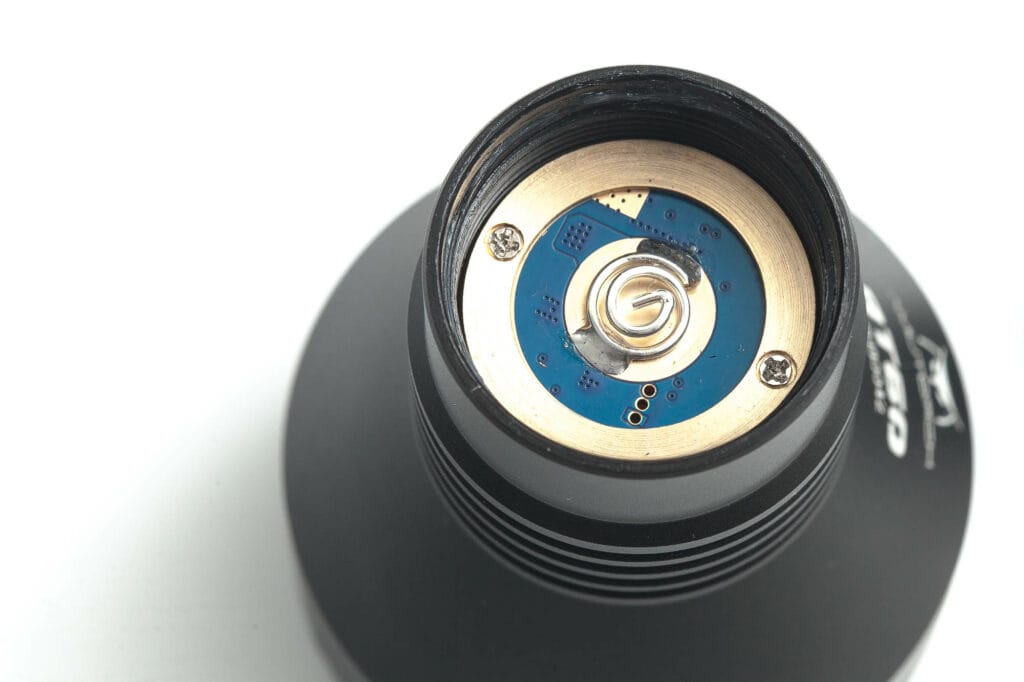
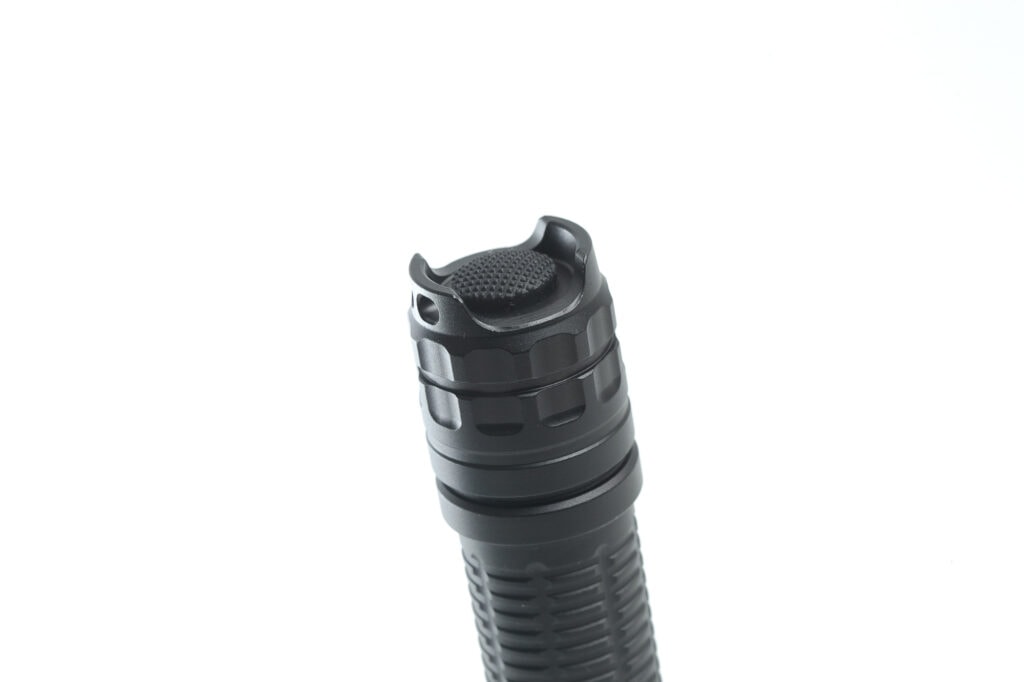
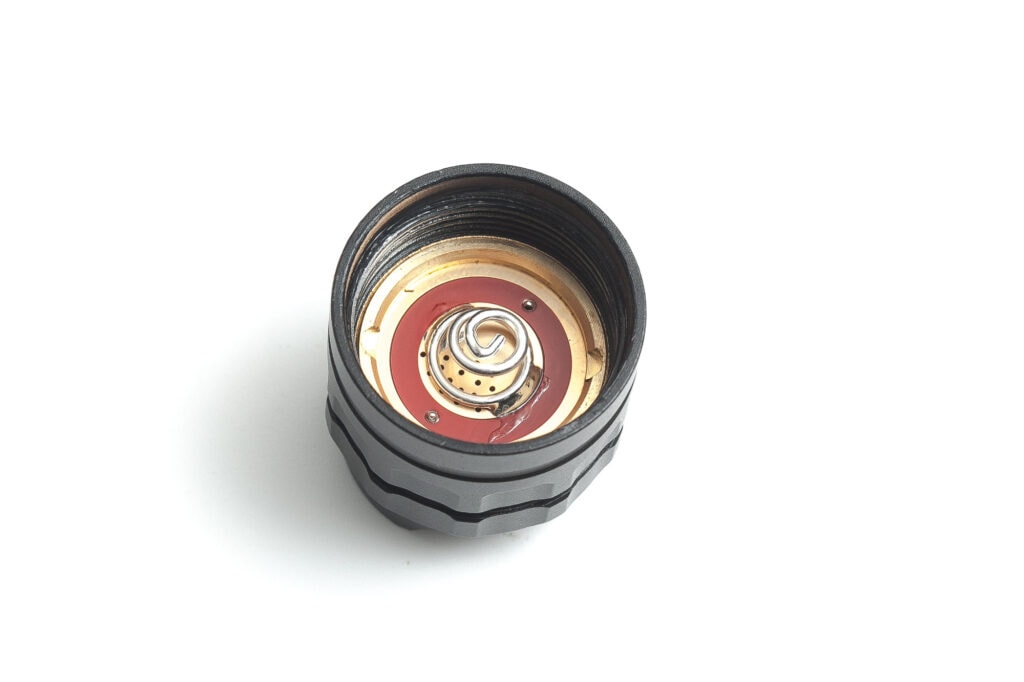
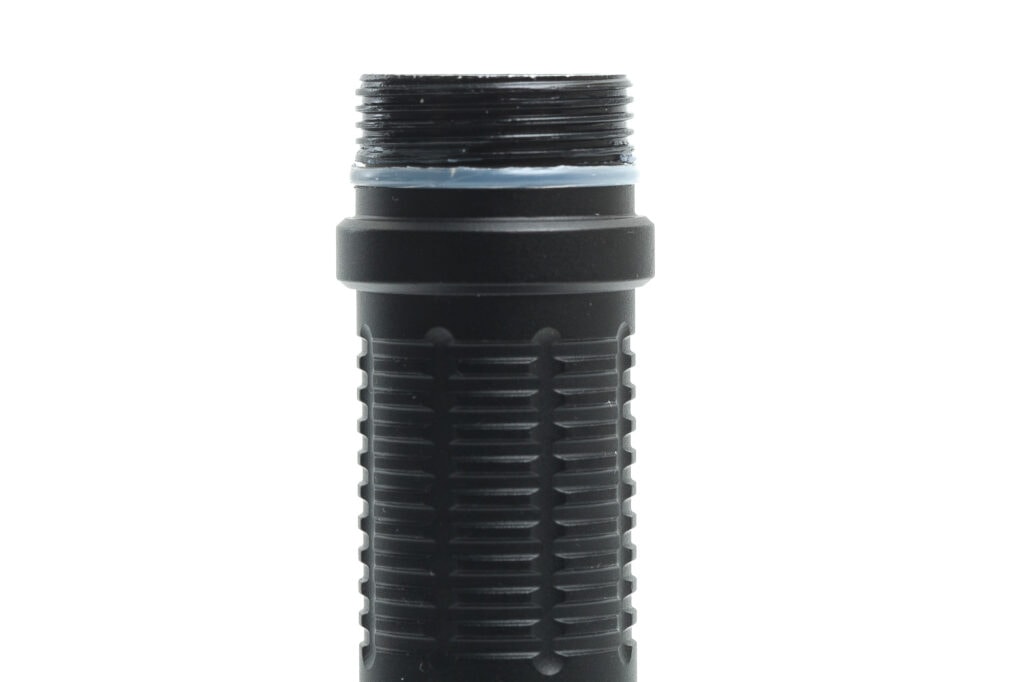
LEP, Lens, Bezel, Beam, and Reflector
There are currently 2 types of LEP flashlight modules: mirror type, and a shine-through type (or backlit type as you may call it). The mirror-type LEPs are still the best performers and throw the farthest, but usually suffer from a not-so-nice beam profile. On the contrary, the shine-through types (like the BT60) don’t throw as far but often have a more pleasant beam.
Every LEP uses a convex-type lens to ‘guide’ the light into a narrow beam. And on some flashlights, the convex lens is the first lens you see from the front. Meaning: the lens is exposed to damage, dirt, and stuff. Fortunately, Amutorch added a protective lens in front of the convex lens, which is easier and cheaper to replace… just in case. And the bezel isn’t strongly crenelated, so you can still put it down, and notice the light is turned on, by the light leaking. .
The BT60 uses the shine-through LEP module and gives a fairly nice and even beam. No color shifts and artifacts are visible to the eye at a larger distance. On a white wall, indoors, you can definitely some tint shifts, but outdoors, and at longer ranges, these are negligible.
I used the Light Master III light meter to see what CCT and CRI numbers it would get.
I tried measuring at 5 meters distance, but high mode washes out the meter, and doesn’t work. Then I tried measuring low mode at 5 meters. That was a bit better to do, but the CCT changes so much by only changing the direction of the flashlight by a few millimeters. But anyway, it’s somewhere between 7000 and 8000K, and CRI (Ra) around 60 or so. Very low, as we would expect.
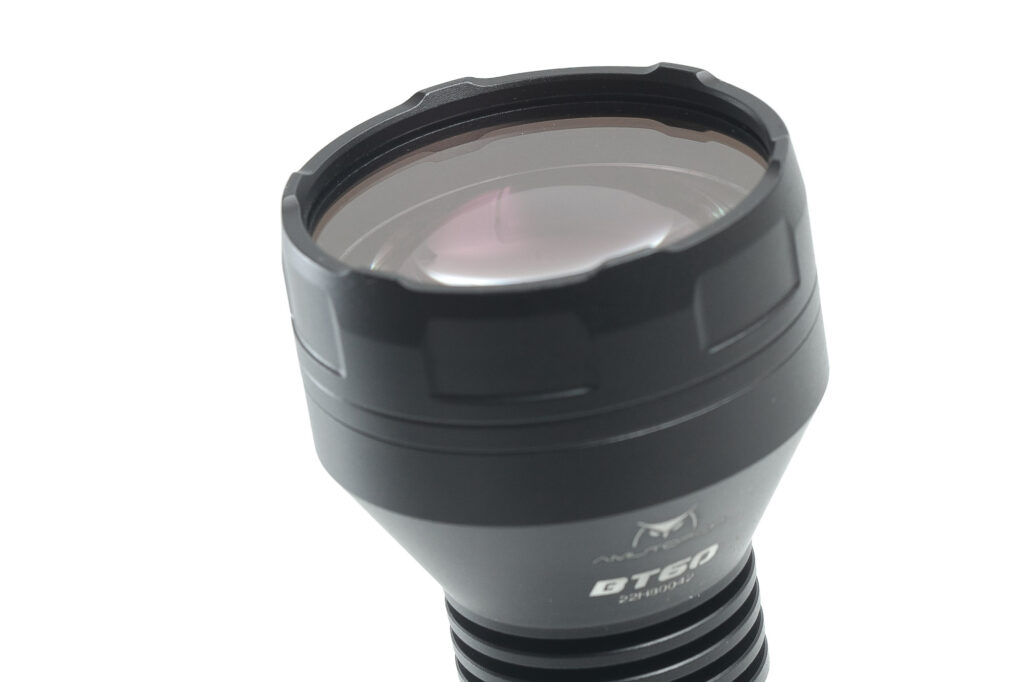
Dimensions and size comparison
Amutorch BT60 dimensions:
| Amutorch BT60 | Millimeters | Inches |
|---|---|---|
| Length | 166 mm | 6.5 “ |
| Head diameter | 60 mm | 2.4 “ |
| Body diameter | 26 mm | 1.0 “ |
Weight:
| Amutorch | Weight in grams | Weight in Oz. |
|---|---|---|
| Without battery: | 240 grams | 8.48 oz. |
| With Samsung 50G battery | 310 grams | 10.93 oz. |
LEP Flashlights comparison
Size compared to other LEP flashlights
Group 1, front row from left to right: Maxtoch L2Ks, Lumintop Thor 3, Astrolux WP2, Nextorch T20L, Amutorch BT60.
Rear row, from left to right: Jetbeam M1X WP-RX, Weltool W4, Jetbeam RRT M1X Raptor, Astrolux WP3, Acebeam W30, Weltool W4 Pro
Group 2: from left to right in zigzag pattern: Amutorch BT60, Nextorch T20L, Astrolux WP2, Lumintop Thor 3, Maxtoch L2Ks, Jetbeam M1X WP-RX, Weltool W4, Jetbeam RRT M1X Raptor, Astrolux WP3, Acebeam W30, Weltool W4 PRO.
Group 3: Amutorch flashlights, BT60 and BT35
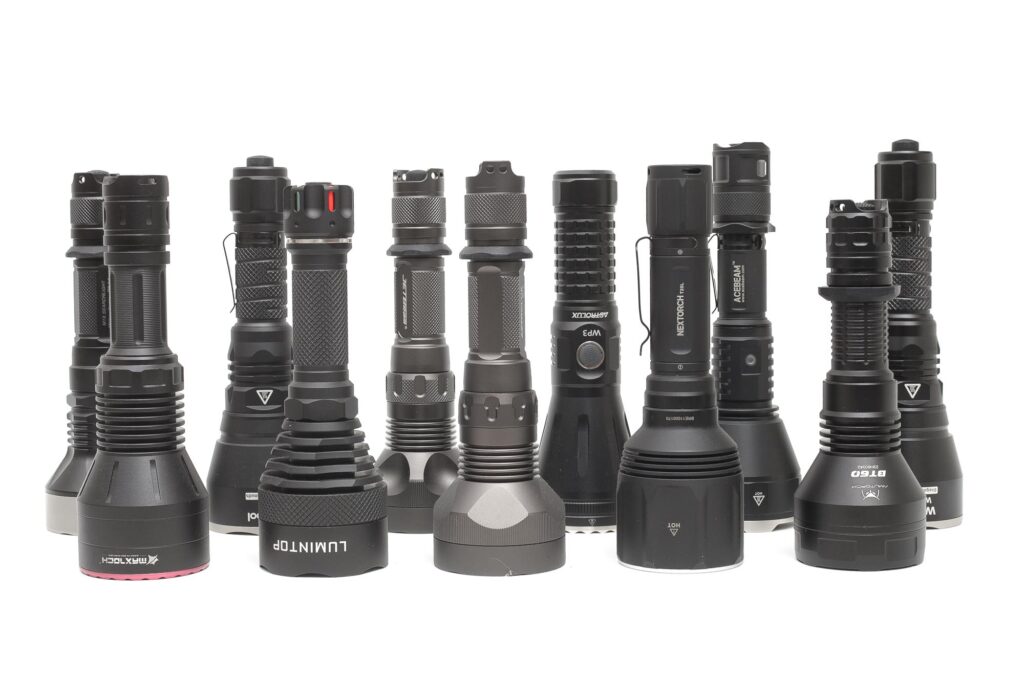
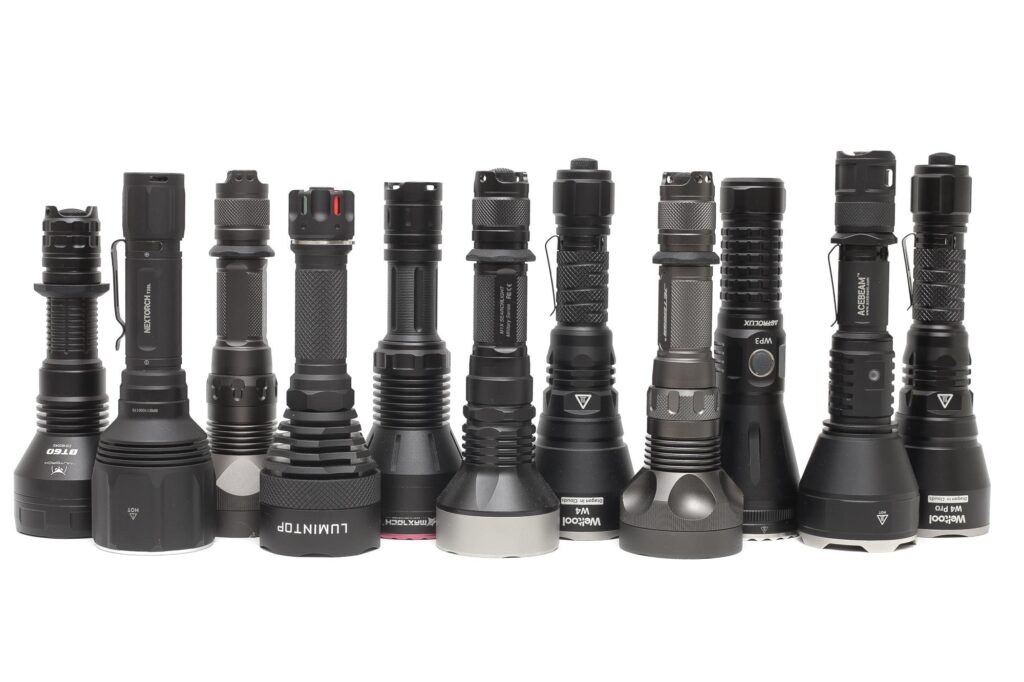
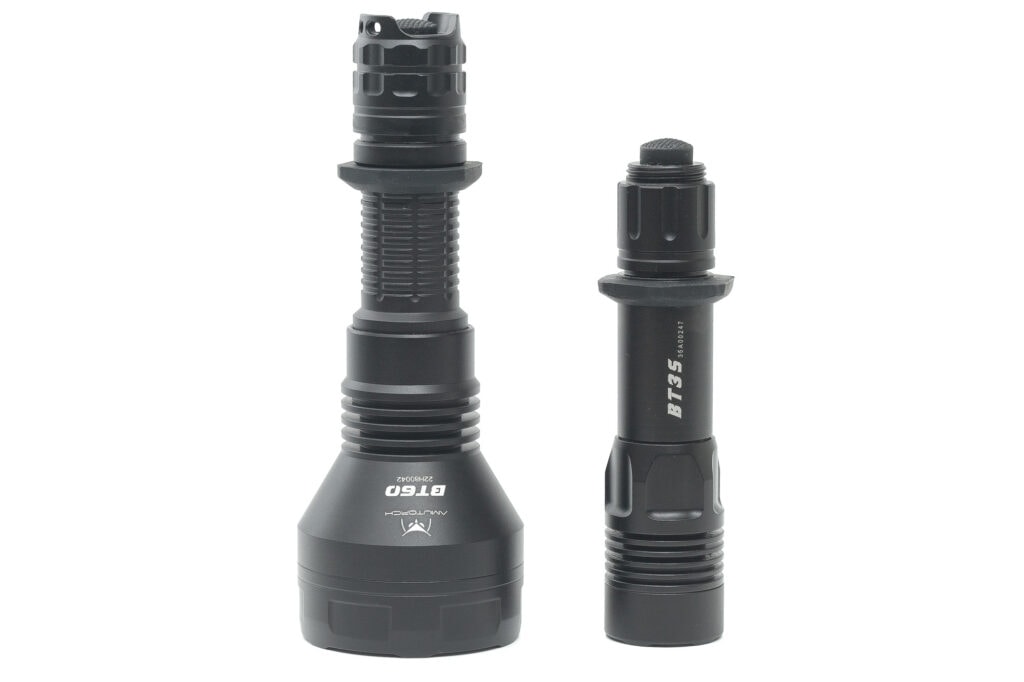
Driver & User Interface:
Alright, this part is again very simple and straightforward. The Amutorch BT60 has just 2 modes, high and low.
Available main modes:
- Low, High
Available special modes (blinkies):
- None
From OFF:
- 1 half-press: momentary on
- Multiple half-presses: switching between high and low mode
- Single-click: activate the light
From ON:
- Single-click: off
Shortcuts:
- There are no shortcuts. And since it has mode memory, you might not know what mode the light is currently in. But since it only has 2 modes, that’s not a major issue at all.
Mode memory:
- Yes, it memorizes the last used mode
Blinky modes menu:
- Nope, it doesn’t have any blinky modes.
Low battery warning:
- Just before the light turns off in low mode, the light starts blinking.
Lock-out mode:
- None, unnecessary with a mechanical switch
PWM:
- Not visible by eye
Firmware / UI Conclusion:
Since LEP flashlights are only used for very specific use cases, the simple UI is wonderful. Only 2 modes, so you don’t get winded up in some hidden strange modes or something.
Batteries & Charging
Most Amutorch lights I have come across didn’t have onboard charging. That can be a pity, but for the manufacturer, it’s a lot easier. Especially if you want to do it correctly. That would add quite a bit of cost.
So, I just spilled the beans.. the BT60 also has no onboard charging.
I did all the testing with Samsung 21700 50G batteries, as they are a great average, with high capacity and decent discharge rates.
On both ends of the flashlight (driver and tailcap) there are very short and strong springs. And in combination with a short battery tube, only unprotected 21700’s will fit. Perhaps some unprotected button tops work, but definitely not with protection boards or USB port. You are likely to damage something if you try to.
Performance test
Lumen measurements:
The output measurements in this review are based on my homemade integrating spheres, each equipped with an Extech SDL400 Lux Meter. For consistency and accuracy, a calibration light (Convoy S2+ with 249lm and a Convoy S2+ with 261lm) is measured prior to each set of lumen measurements.
For high-output lights, one of the lux meters uses an ND camera filter to prevent the lux meter to max out. This is either the Kenko PRO1D ND16 up till about 80,000 lumens or Gobe ND32 for anything above.
All of my readings were taken from a fully-charged Samsung 21700 50G.
The measurements were taken manually at turn on and 30 seconds. The 10-minute numbers are taken from the runtime graph.
| Mode | Specs | at turn on | 30 seconds | 10 minutes |
|---|---|---|---|---|
| Low | 100 | 104 | 104 | 103 |
| High | 400 lm | 323 | 316 lm | 303 |
Low was specced pretty trustworthy, but I couldn’t reach the 400lm of the high mode.
Parasitic drain:
- None, because is has a mechanical switch.
Amutorch BT60 battery life and runtime graphs
The runtime tests were done in the 50cm home made integrating sphere, combined with the Extech SDL400 data logging Lux Meter.
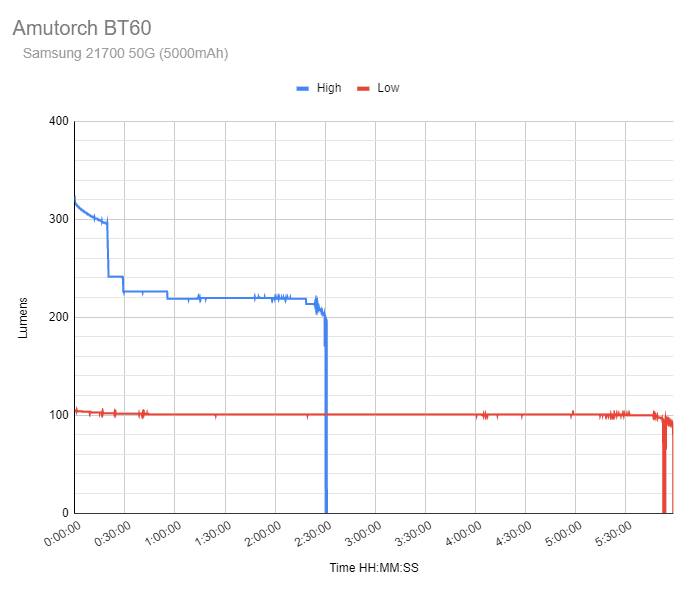
| Mode | Specified | Measured runtime (ANSI FL1) | Time till shut off |
|---|---|---|---|
| Low | 6h 45min | 5h 58min | 5h 58min |
| High | 2h | 2h 31min | 2h 31min |
I noticed that the light started flickering in Low mode just before the runtime finished.
ANSI FL1 standards: The runtime is measured until the light drops to 10% of its initial output (30 seconds after turn on). This does not mean that the flashlight is not usable anymore. The last column shows how long the light actually works till it shuts off. If there is a + symbol, it means that the test was stopped at that particular point, but the light was actually still running. This happens on certain occasions, with certain drivers, firmware, or batteries.
Amutorch peak beam intensity and beam distance measurements
Measurements were taken outdoors at 20 meters, with a Hagner E4-X Lux Meter. The measurements were taken 30 seconds after turn on.
| Mode | Specified | Candelas measured | Meters | Yards | Miles |
|---|---|---|---|---|---|
| Low | – | 584,800 cd | 1529 | 1673 | 0.95 |
| High | 2560m | 1,644,000 cd | 2564 meters | 2804 | 1.59 |
I must admit… I don’t think I have ever hit the specs of an LEP so precisely.
Extra info: Peak beam distance according to ANSI FL1 standards: The calculated value of distance in meters at which the flashlight produces a light intensity of 0.25 lux. (0.25 lux is about the brightness of a full moon shining on an object).
Amutorch BT60 vs Acebeam W30 vs Nextorch T20L vs Lumintop Thor 3, etc.
2 images: the dark blue line is from the Amutorch BT60 in both of the following images.
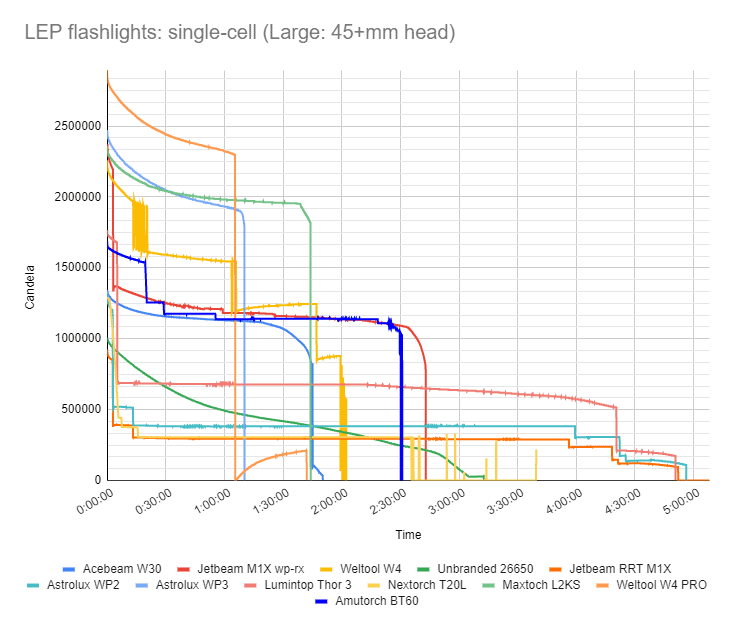
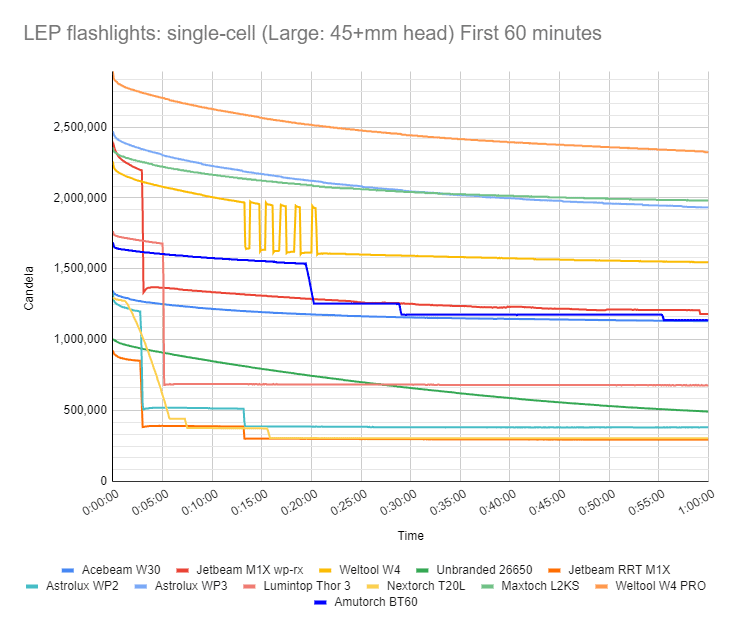
Candela comparison: best single-cell large head LEP flashlights
A list of the best single-cell LEP flashlights with large heads we reviewed: These numbers are NOT from the specifications but are measured by our reviewers. They include all single-cell LEP flashlights with large heard (+-60mm and above). The numbers include the measurement in lumens (lm), measure candela (cd), and calculated distance in meters, and yards. These numbers are all measured 30 seconds after turning on.
| Flashlight (click for review) | @30sec (lm) | Candela (cd) | Meters | Yards |
|---|---|---|---|---|
| Acebeam W30 | 498 | 1,312,000 | 2291 | 2505 |
| Acebeam W35 | 733 | 1,892,000 | 2751 | 3009 |
| Amutorch BT60 | 316 | 1,644,000 | 2564 | 2804 |
| Astrolux WP2 | 303 | 1,248,000 | 2234 | 2443 |
| Astrolux WP3 | 445 | 2,412,000 | 3106 | 3397 |
| FireFlyLite LEP01 | 391 | 816,000 | 1807 | 1976 |
| Jetbeam M1X WP-RX | 491 | 2,280,000 | 3020 | 3302 |
| Lumintop Thor 3 | 311 | 1,728,000 | 2629 | 2875 |
| Maxtoch L2KS | 442 | 2,308,000 | 3038 | 3323 |
| Nextorch T20L | 975 | 1,284,000 | 2266 | 2478 |
| NlightD L1 | 513 | 1,940,000 | 2786 | 3046 |
| Weltool W4 | 450 | 2,184,000 | 2956 | 3232 |
| Weltool W4 PRO | 550 | 2,808,000 | 3351 | 3665 |
And below is an interactive throw comparison graph (candela), between the best single-cell LEP flashlights with large heads. Hover your mouse over the interactive graph below to see the details of each specific light.
(tip: hold your mobile phone horizontally to see the full graph). Or visit the full interactive graph here.
The next graph shows the same graph, but then focusing on the first 60 minutes of their runtimes. Or view the full 60min interactive graph here.
Beamshots
For the beamshots of the tower, I used a Canon EOS 5D Mk2 with a 100mm lens. Manual settings: ISO1600, 0.5sec, F4, 5000K
The tower is about 450 meters / 492 yards away.
I compared the following LEP flashlights.
The first image shows the LEP very close to the camera. Therefore, you can see the beam so well.
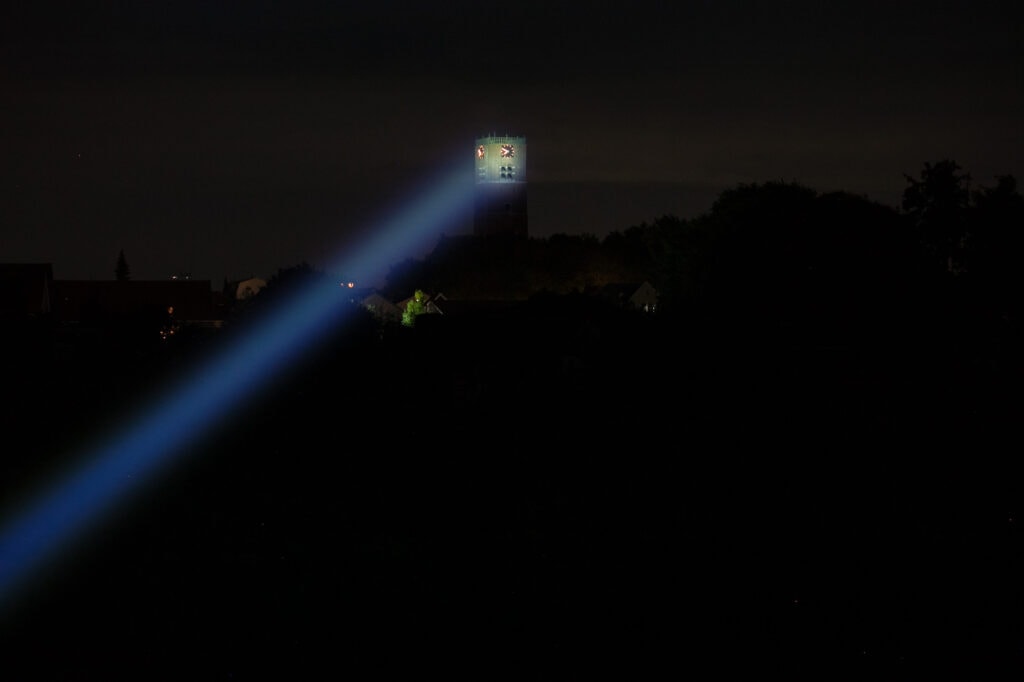
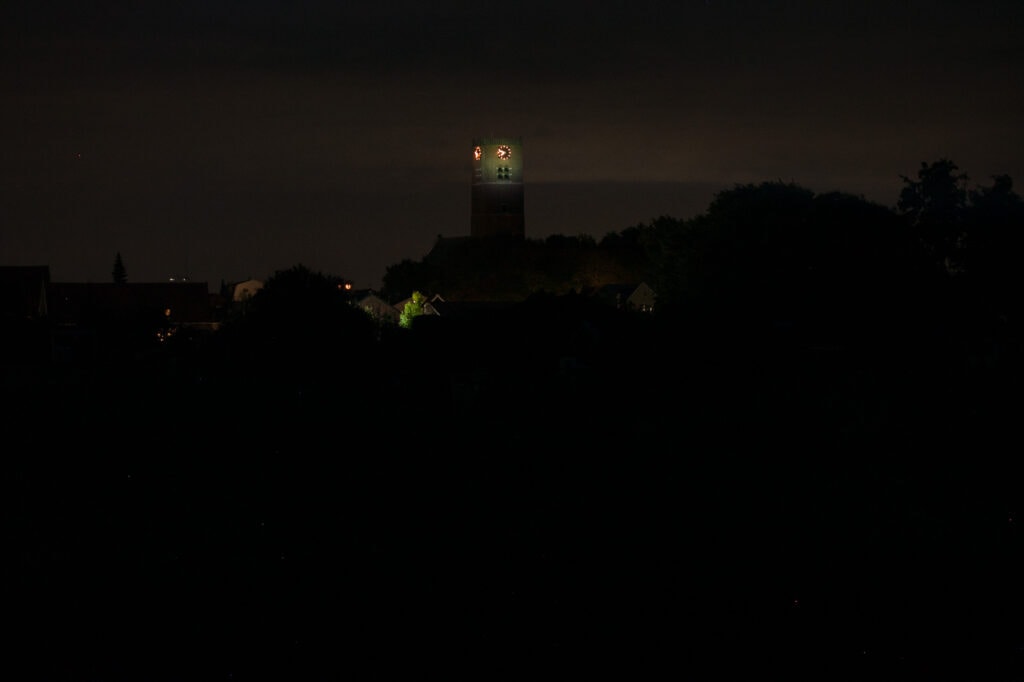
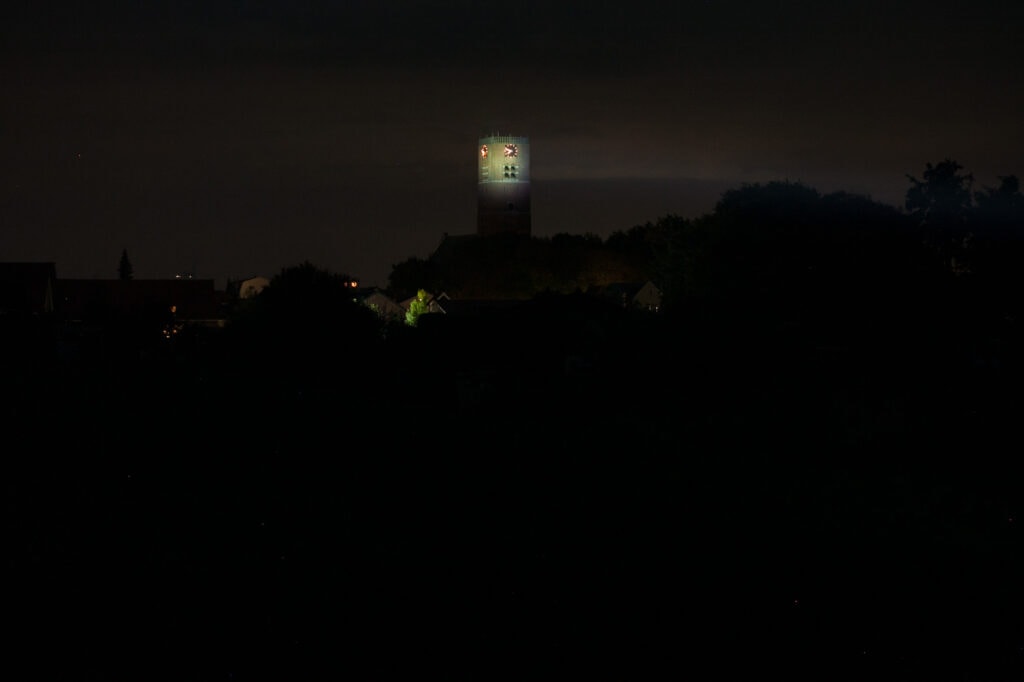
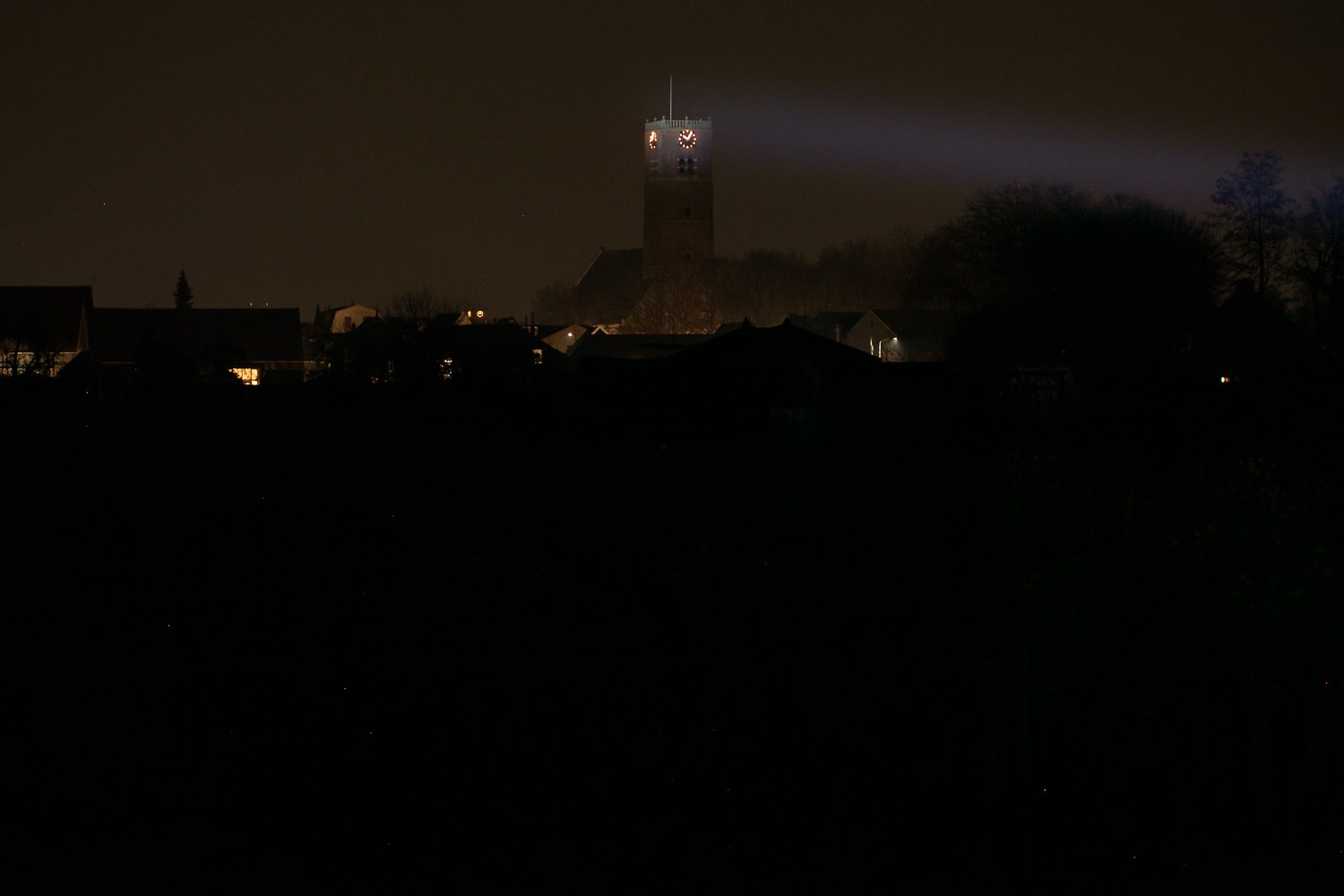
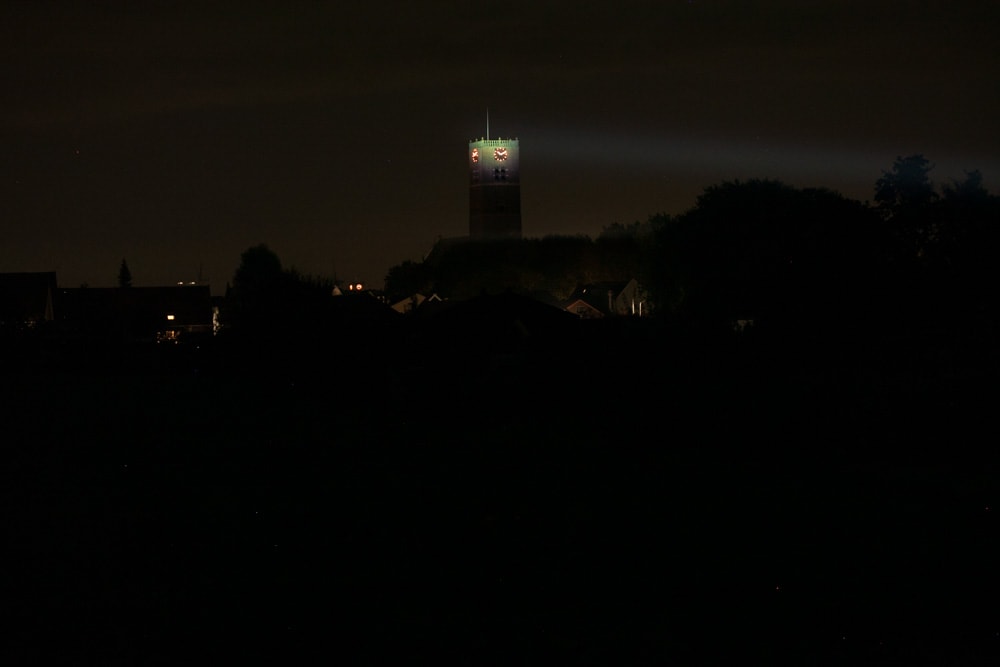
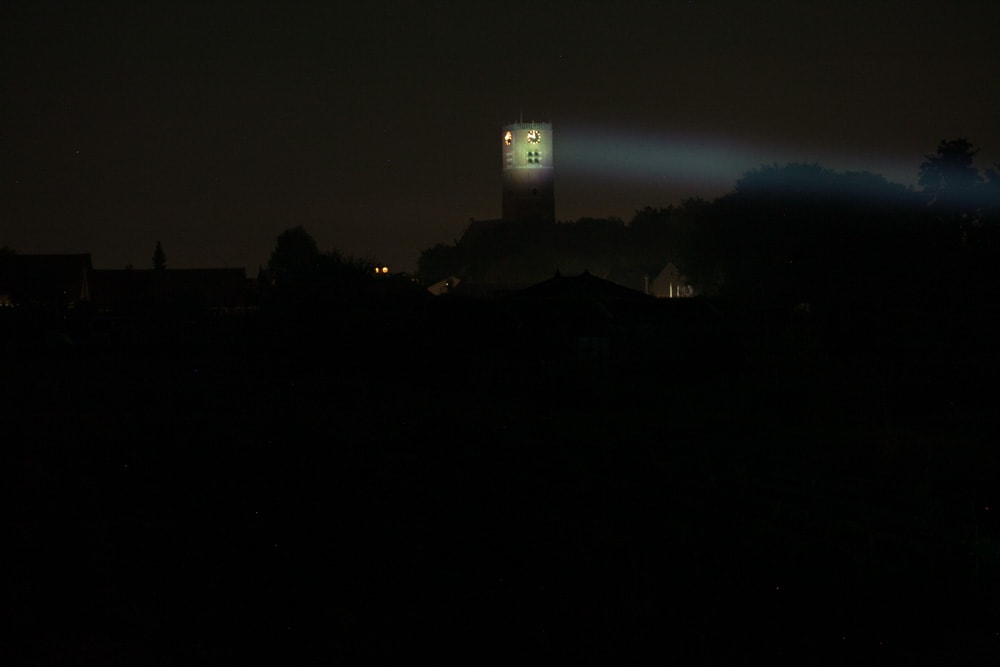

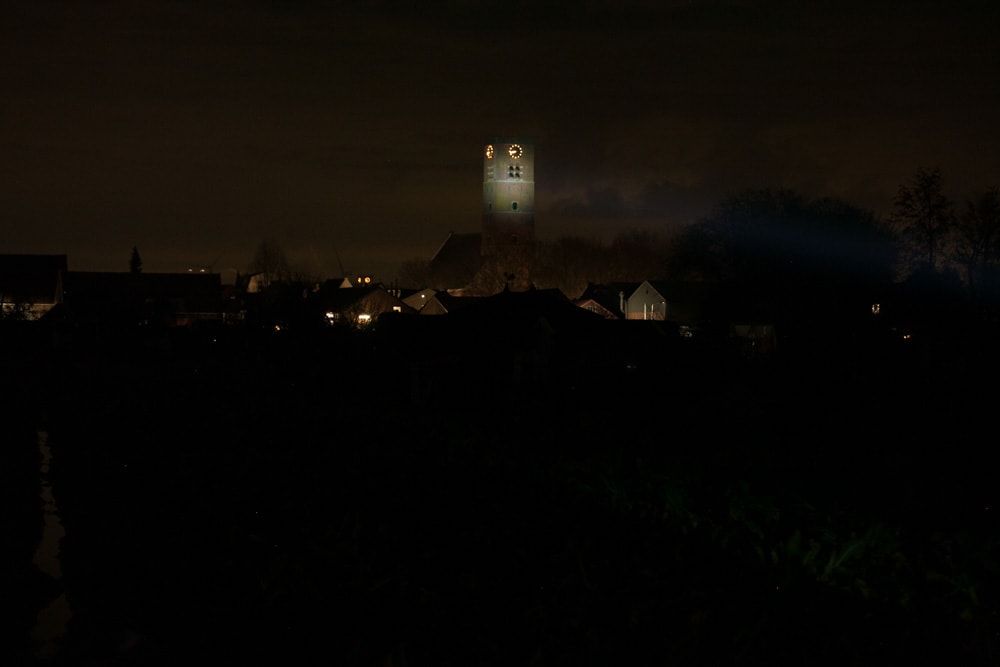
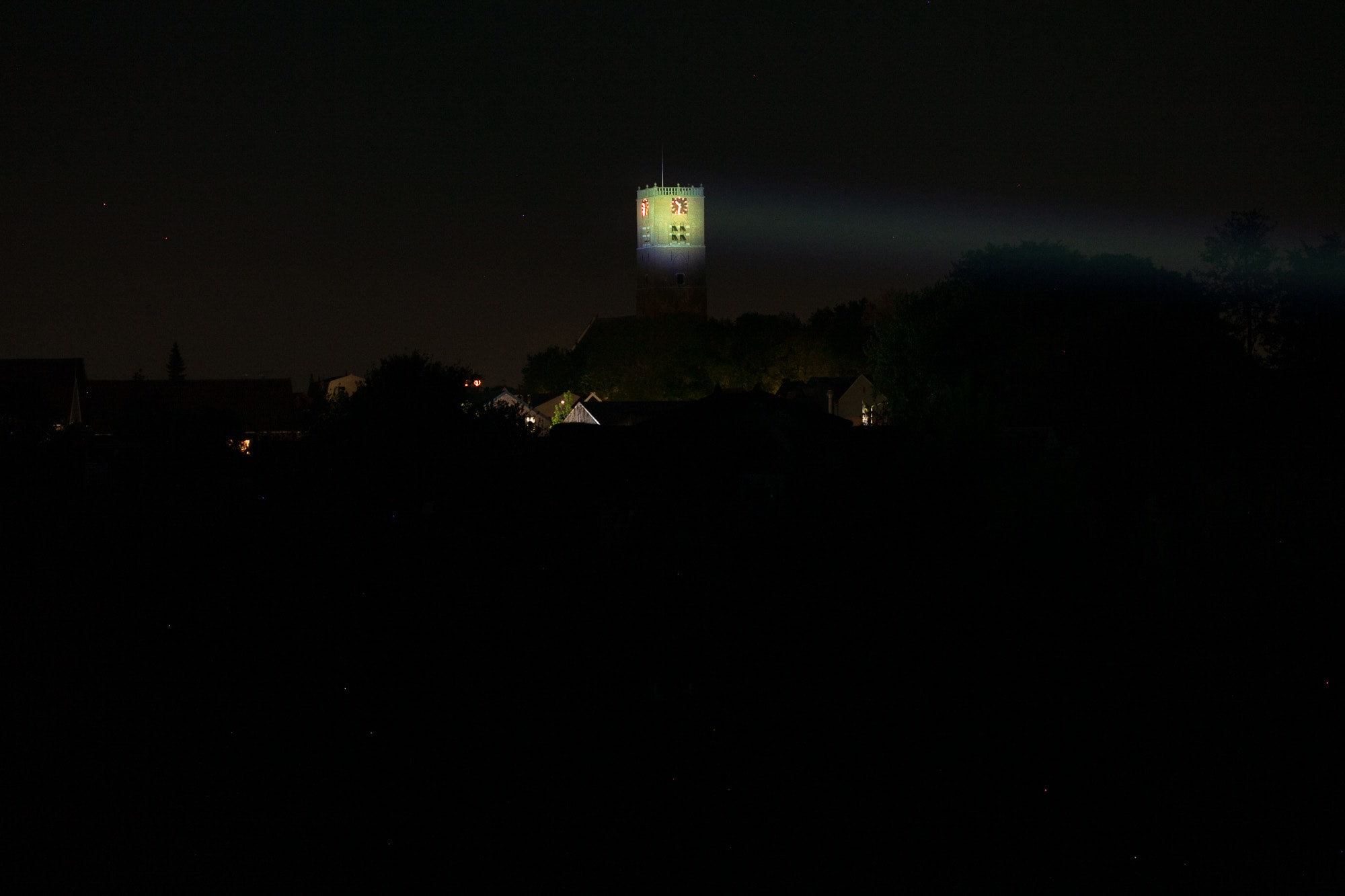
Disclaimer: This flashlight was sent to me for review at no cost by Nealsgadgets. I have not been paid to review, nor have I been holding back on problems or defects.
Final Verdict
Pros
- Shortest light in its category (single cell big head LEP)
- Throws really far!
- Protective lens
- Easy UI with only 2 modes
- Spot on with specified candelas
Cons
- Mode memory (I’d prefer to have it always start in High)
- Not much attention to detail or design.
- No battery included
Explanation on star ratings:
1: Avoid: my phone flashlight would be a better choice – 2: Poor: significant defect or issues; almost unusable – 3: Average: some defects or issues; but still usable 4: Good: recommended (minor issues) – 5: Great: highly recommended
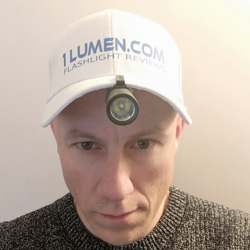
4.5 stars: ★★★★⋆
For the first 20 minutes, you get a pretty stable 1.5 million candelas. And even after the drops, it stays above 1 million candelas for the whole runtime in High mode. 1 million candelas means 2,000 meters / 1.2 miles.
For the price, you get a pretty solid performer. Look at all the graphs and tables above to see if this fits your needs.
Amutorch BT60 discount code
Use our exclusive 25% discount coupon code at Nealsgadgets: 1LumenLEP (Should work on all LEPs at Nealsgadgets).
1lumen selects and reviews products personally. We may earn affiliate commissions through our links, which help support our testing.